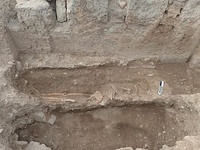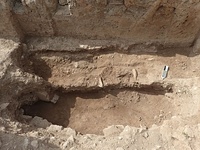| Collection: | Corinth | |
| Type: | Basket | |
| Name: | Temple E, Southeast, context 1012 | |
| Area: | Temple E, Southeast | |
| Context Type: | Skeleton | |
| Title: | Inhumation in N. Side of 2016-08 | |
| Category: | Deposit | |
| Notebook: | 1110 | |
| Context: | 1012 | |
| Date: | 2016/06/07 | |
| Notes: | This is an inhumation that was first observed as a spinal column protrucing from the south scarp of Grave 2016-07. It was truncated by cut 993. The inhumation is essentially on the edge of Grave 2016-08. The inhumation includes a more or less in situ mandible, but does not include a cranium. The cranium was likely taken out with bone jumble 992. It was probably the more fragmented skull on the SW edge of Grave 2016-07. The mandible sits on top of articulate cervical vetebrae, which are articulated with the rest of the spinal column. The trunk appears slightly twisted to the south. The forearms are crossed over the chest with the right over the left. There is a tile perpendicular to the cervical vetebrae that might have propped the head up. The sacrum is missing as may be the lumbar vertebrae. There is a disarticulated mandible directly to the south of the R os coxa, there is no L os coxa. One the feet and legs were exposed it became clear that they too were twisted slightly to the south. The left lower limb is higher than the right lower limb. The feet are parallel to one another with the plantar aspect down. 2016/06/08 The right ribs have been preserved, but the lumbar and thoracic vetebrae have not been. The "spinal column"we were seeing in the south scarp of Grave 2016-07 was actually the heads of ribs. There is an articulated hand just outside of the right ribs that does not actually seem to belongn to this individual. The orientation is not correct. Upon further consideration, the hand is a left hand that may be associated with the left forearm which was crossed over the chest, under the right forearm. The wrist may have been snapped back so that it lay on its dorsal aspect, palmar side up. The fingers then fell, articulated, over and into the the rib cage as the body decomposed. Although the L os coxa is not present, it is likely that it would have been slightly elevated and twisted south based on the position and elevation of the left lower limb. The feet are parallel, but the metatarsals of the left foot ar neslted within the arch of the right foot. To be clear about the positioning of the skeleton, it appears as though the body was set against the north side of the burial cut. The arms were nicely crossed, but the left hand was somehow bent backwards so that it rested on the dorsal aspect. Those burying the individual did not straighten the body in the grave, but left it lying against the side. The position of the hand might be explained if the person was buried in a shroud which somehow caught the hand in that position. | |
| Period: | Frankish (1210-1458 AD) | |
| Grid: | 128.2-126.4E, 1068.5-1069.3N | |
| XMin: | 126.4 | |
| XMax: | 128.2 | |
| YMin: | 1068.5 | |
| YMax: | 1069.3 | |
| Site: | Corinth | |
| City: | Ancient Corinth | |
| Country: | Greece | |
| Masl: | 84.83-84.98m. | |
| References: | Images (4) |
|
Show All Results (3,986) Reports (18) Plans and Drawings (318) Images (2,069) Baskets (1,569) Notebooks (3) References Images (4) Classifications Sign in Provide feedback |
|


